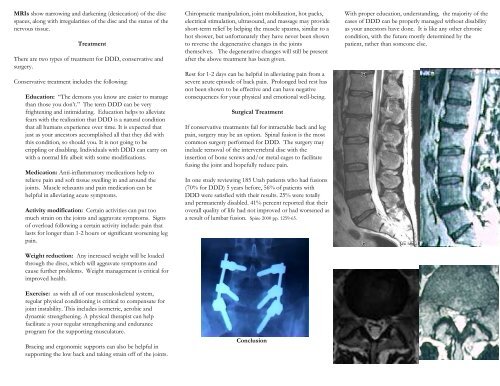Degenerative Disc Disease - Home Page of Alan Colledge MD
Degenerative Disc Disease - Home Page of Alan Colledge MD
Degenerative Disc Disease - Home Page of Alan Colledge MD
You also want an ePaper? Increase the reach of your titles
YUMPU automatically turns print PDFs into web optimized ePapers that Google loves.
MRIs show narrowing and darkening (desiccation) <strong>of</strong> the disc<br />
spaces, along with irregularities <strong>of</strong> the disc and the status <strong>of</strong> the<br />
nervous tissue.<br />
Treatment<br />
There are two types <strong>of</strong> treatment for DDD, conservative and<br />
surgery.<br />
Conservative treatment includes the following:<br />
Education: “The demons you know are easier to manage<br />
than those you don’t.” The term DDD can be very<br />
frightening and intimidating. Education helps to alleviate<br />
fears with the realization that DDD is a natural condition<br />
that all humans experience over time. It is expected that<br />
just as your ancestors accomplished all that they did with<br />
this condition, so should you. It is not going to be<br />
crippling or disabling. Individuals with DDD can carry on<br />
with a normal life albeit with some modifications.<br />
Medication: Anti-inflammatory medications help to<br />
relieve pain and s<strong>of</strong>t tissue swelling in and around the<br />
joints. Muscle relaxants and pain medication can be<br />
helpful in alleviating acute symptoms.<br />
Activity modification: Certain activities can put too<br />
much strain on the joints and aggravate symptoms. Signs<br />
<strong>of</strong> overload following a certain activity include: pain that<br />
lasts for longer than 1-2 hours or significant worsening leg<br />
pain.<br />
Weight reduction: Any increased weight will be loaded<br />
through the discs, which will aggravate symptoms and<br />
cause further problems. Weight management is critical for<br />
improved health.<br />
Exercise: as with all <strong>of</strong> our musculoskeletal system,<br />
regular physical conditioning is critical to compensate for<br />
joint instability. This includes isometric, aerobic and<br />
dynamic strengthening. A physical therapist can help<br />
facilitate a your regular strengthening and endurance<br />
program for the supporting musculature.<br />
Bracing and ergonomic supports can also be helpful in<br />
supporting the low back and taking strain <strong>of</strong>f <strong>of</strong> the joints.<br />
Chiropractic manipulation, joint mobilization, hot packs,<br />
electrical stimulation, ultrasound, and massage may provide<br />
short-term relief by helping the muscle spasms, similar to a<br />
hot shower, but unfortunately they have never been shown<br />
to reverse the degenerative changes in the joints<br />
themselves. The degenerative changes will still be present<br />
after the above treatment has been given.<br />
Rest for 1-2 days can be helpful in alleviating pain from a<br />
severe acute episode <strong>of</strong> back pain. Prolonged bed rest has<br />
not been shown to be effective and can have negative<br />
consequences for your physical and emotional well-being.<br />
Surgical Treatment<br />
If conservative treatments fail for intractable back and leg<br />
pain, surgery may be an option. Spinal fusion is the most<br />
common surgery performed for DDD. The surgery may<br />
include removal <strong>of</strong> the intervertebral disc with the<br />
insertion <strong>of</strong> bone screws and/or metal cages to facilitate<br />
fusing the joint and hopefully reduce pain.<br />
In one study reviewing 185 Utah patients who had fusions<br />
(70% for DDD) 5 years before, 56% <strong>of</strong> patients with<br />
DDD were satisfied with their results. 25% were totally<br />
and permanently disabled. 41% percent reported that their<br />
overall quality <strong>of</strong> life had not improved or had worsened as<br />
a result <strong>of</strong> lumbar fusion. Spine 2000 pp. 1259-65.<br />
Conclusion<br />
With proper education, understanding, the majority <strong>of</strong> the<br />
cases <strong>of</strong> DDD can be properly managed without disability<br />
as your ancestors have done. It is like any other chronic<br />
condition, with the future mostly determined by the<br />
patient, rather than someone else.


